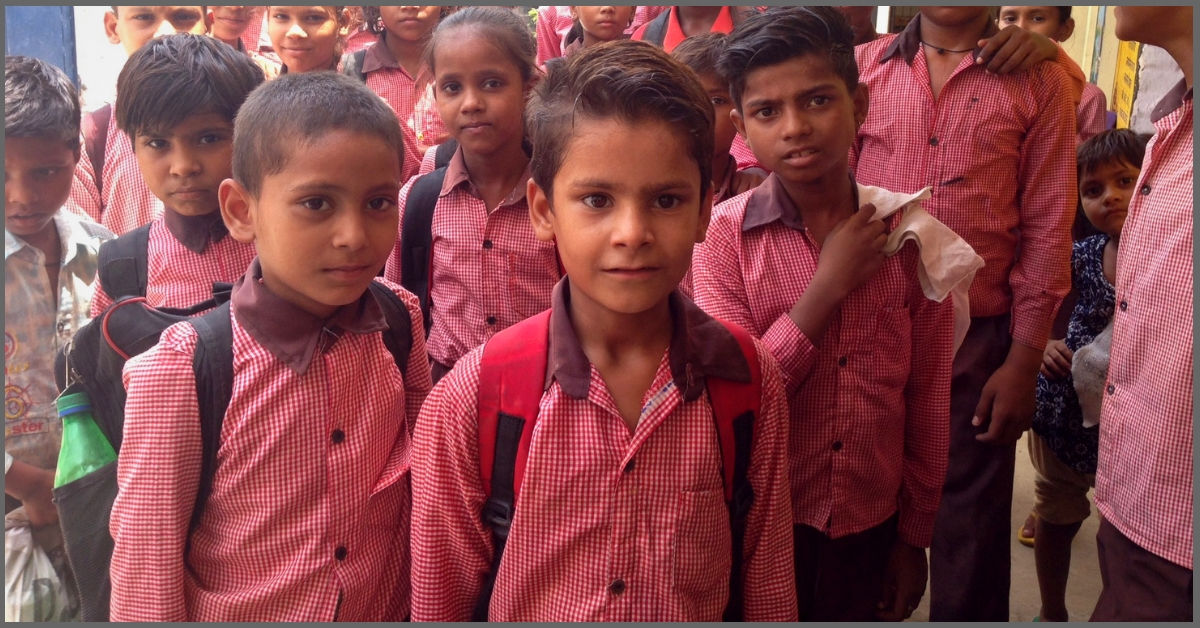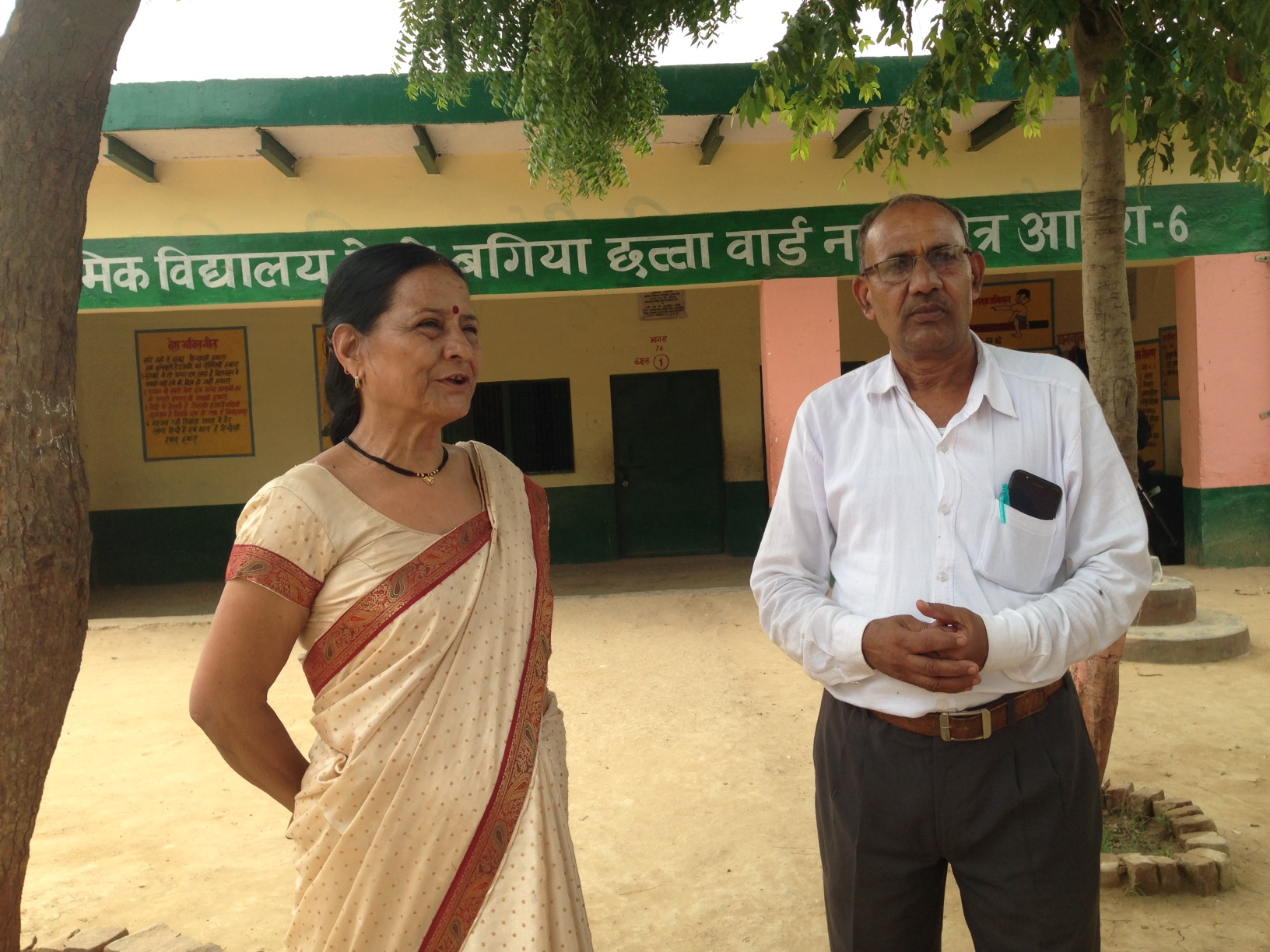Agra Govt School Harvests Over 1 Lakh Litres of Rain/Year, Improves Health of Kids!
Additionally, because of the salinity and hardness of the water, annual expenditure on cooking fuel had increased to Rs 4,000, which is now being saved.

Shital Kumari is a student at the Tedi Bagia Government Middle School in Ambedkar Nagar, Agra. But a couple of years ago when the 14-year-old was in Class 5, she almost dropped out, following a bad bout of typhoid, a bacterial infection caused by drinking contaminated water. Staying at home for more than three months because of her illness, Kumari recovered just in time for her final examinations.
Kumari was lucky. But other students of this school who were also suffering from water-borne diseases were not so fortunate. Many had to drop out because of poor health.

Unsafe water is a prime reason for illnesses like typhoid and diarrhoea. With Agra depending on the Yamuna river for its water supply, which was a limited supply of polluted, saline, and undrinkable water, the likelihood of contracting waterborne diseases remains high, especially among children like Kumari from marginalised communities with little access to safe water.
When students fall ill, they miss classes and even drop out, depending on the severity of the illness.
However, since 2016, not only has the school turned around this narrative, but it is also reducing Agra’s water scarcity. Becoming the first government school to install a rainwater harvesting (RWH) tank three years ago meant that the administration no longer had to worry about water shortage despite being in Tedi Bagia, a water-starved area.
More importantly, with lab tests indicating the higher quality of the harvested rainwater vis-à-vis commercially available water tankers and bottled mineral water, students like Kumari no longer worry about falling ill.
India registered 69.14 million cases of four water-borne diseases (diarrhoea, typhoid, cholera, and hepatitis) from 2012-17. According to a World Health Organisation study, India contributed to 22 per cent of the global deaths due to diarrhoea among under-five children, which is an estimated 1,17,000!
However, these deaths can be easily prevented through improved access to water, sanitation, and good hygiene.

Kumari says, “My younger sister and brother also study at this school. But they did not face any health problems because the rainwater tank became operational around the time they joined the school. I don’t want to fall ill again, so sometimes I fill my water bottle with this safe drinking water before I go home.”
The school houses primary and middle sections, and this system benefits 300 students between the ages of 7-15. Moreover, there has been a 17 per cent decline in cases of diarrhoea and other waterborne illnesses since the installation of the two RWH tanks.
It’s not just the health and hygiene of the children which has improved. So far, the school has harvested over one lakh litres of rainwater each year, apart from saving Rs 1,500 every month that would otherwise have been spent in buying poor quality drinking water from tankers. Additionally, because of the salinity and hardness of the water, annual expenditure on cooking fuel had increased to Rs 4,000, which is now being saved.
Thanks to the efforts by the students and the school management committee (SMC) comprising parents and teachers, there has been timely maintenance of the RWH tanks. The school has harvested over 2,80,000 litres of rainwater from the roof of its buildings in the last three years!

In fact, students formed a committee to monitor the cleanliness of the roof to ensure that there was no contaminant near the down pipe system that collects rainwater. They also made sure that the two taps connected to the 300-litre tank were not left open after use because that was where the filtered potable rainwater was pumped, to be used for drinking.
M L Sharma, the school principal, says, “This means that the water collected through rainwater harvesting has made us water-resilient for 12.8 months. In addition to helping us tide over the water crisis, the RWH initiative has saved us over Rs 70,000 so far.”
But the school’s struggle to get safe water would have continued, had it not been for a fortuitous meeting in 2016 with the Centre for Urban and Regional Excellence (CURE), a non-profit. CURE was working to improve water resilience in Agra and reached out to Sharma when their survey indicated that Tedi Bagia was facing acute water shortage.
When he heard about the benefits of a RWH tank, Sharma took a quick decision. “I understood how beneficial it would be for the students and the school. CURE promised to provide the technical and financial support. So, I agreed and took the responsibility to convince the SMC. The government Basic Education Department was also kept in the loop. Once everyone was convinced, we helped in identifying where the underground tanks could be installed, and work began,” says Sharma.
After 19 feet of excavation, circular structures of stone were made in the ground. The catchment area on the roof of the school building was prepared by constructing parapet walls of bricks. Pipes, through which water would flow from the roof catchment to the underground drain, were then installed along the length of the wall.
“The idea behind the RWH system design was to catch every drop of water that was likely to fall on the roof in two underground circular tanks with capacities of 80,000 litres and 35,000 litres, respectively. The tanks are connected to the rooftops through a system of pipes and drains. The overflow of the tanks is channelised to a common groundwater recharge pit,” says Siddharth Pandey, associate director, CURE.
Using filtered rainwater for cooking mid-day meals has also improved taste and quality. Babli Devi and Satwati Devi, the two women in charge of cooking, vouch for this.

Babli Devi says, “Our daughters also study at this school. They were the first to tell us about the improvement in the taste. We have also found that it takes us less time to cook when we use this water, and the children enjoy the meals.”
One big outcome of harvesting rainwater has been the improvement in school enrollment and attendance, especially among girls. Sanitation facilities have improved, thanks to increased availability of water, helping to keep girls in school. There has been an increase of 11.3 per cent over the last three years. This is an achievement considering Agra was among the 10 top cities in Uttar Pradesh which showed a dip in enrollment in government schools in the last academic year, according to UP state education department ‘School Chalo Abhiyan’ report.
This has impressed even the state government’s Basic Education Department in Agra. According to Omkar Singh, Basic Education Officer, “The department is considering how this can be replicated in more schools. We shall also look at how Kasturba Gandhi Balika Vidyalayas (the residential school for out-of-school girls) can benefit from this initiative.”
Such has been the impact that two more government schools located in water-scarce areas followed the Tedi Bagia model. The first one was the school in Kalindi Vihar. When L P Singh, a teacher at this school heard about the RWH initiative, he informed the school principal. Once the decision to install one for the 200 students at their school was taken, they approached CURE for help.

Since its installation in 2017, efforts by the students and teachers at the Kalindi Vihar School over two years have led to the collection of 71,500 litres of rainwater. It is water-resilient for 11.7 months, and the school has saved a sum of Rs 17,875 that it would have spent on buying water from tankers.
Similar success has been achieved by the second government school that also installed a RWH tank with CURE’s help in 2017. This school in Nagla Teen, which has 757 users, including students, teachers, and 80 households nearby; the institution has harvested 84,000 litres of rainwater and saved Rs 21,000 on water expenses to date.
By inspiring residents of Ambedkar Nagar to follow their water conservation example, the Tedi Bagia School is reducing water stress. At the forefront of this effort are a group of women, including mothers of children studying there. The women formed a group to help conserve water in their slum, showing the way by installing small rainwater harvesting structures at their homes, after learning the technique from CURE.
“I installed it at my home at my own cost. The pipe is fitted on the roof, where a small drum of 50-litre capacity filled with brick ballast, charcoal, and gravel filter, collects water. The water is fit for drinking if the roof, pipe, and filter are maintained. I made a one-time expenditure of Rs 500 for the installation. But my savings have been more than doubled since I no longer buy water from the tanker. This means a lot to us as our incomes are not high. I’m happy that six other women in my group understood the benefits and installed such RWH systems in their houses. The school inspired us, and now we are inspiring others to conserve water,” concludes group leader Gayatri Devi.
Also Read: Rainwater Harvesting Helps Bengaluru School Save 50 Lakh Litres of Water/Year!
About half of Agra’s population lives in low-income settlements where water is in short supply. So people buy drinking water and tap groundwater to meet their needs. According to a 2019 Niti Aayog report, Agra is among the 21 cities likely to run out of groundwater by 2020 if urgent steps are not taken. Initiatives to save water like the rainwater harvesting structures installed by the government schools and individual homes have shown that where there is a will, there is a way to overcome the water crisis.
(Edited by Shruti Singhal)
Like this story? Or have something to share?
Write to us: [email protected]
Connect with us on Facebook and Twitter.
If you found our stories insightful, informative, or even just enjoyable, we invite you to consider making a voluntary payment to support the work we do at The Better India. Your contribution helps us continue producing quality content that educates, inspires, and drives positive change.
Choose one of the payment options below for your contribution-
By paying for the stories you value, you directly contribute to sustaining our efforts focused on making a difference in the world. Together, let’s ensure that impactful stories continue to be told and shared, enriching lives and communities alike.
Thank you for your support. Here are some frequently asked questions you might find helpful to know why you are contributing?


This story made me
-
97
-
121
-
89
-
167













